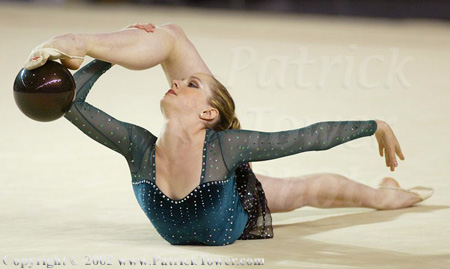RHYTHMIC GYMNASTICS
In 1962 the International Gymnastics Federation officially recognized rhythmic gymnastics as a sport. The first Rhythmic World Championships took place in 1963 in Budapest, Hungary, where 28 athletes from 10 European countries competed. The United States sent its first delegation to the Rhythmic World Championships in 1973.
Rhythmic individual all-around competition was added to the Olympic Games in 1984. In 1996, the rhythmic group event was added as a medal sport at the Olympic Games for the first time.
Rhythmic is an all-girls sport that emphasizes extreme flexibility, dance, lots of ballet, good coordination, and being able to handle the apparatus.
There are five levels of rhythmic gymnastics. Level 5 is the beginning compulsory level, Level 6 the intermediate, and Level 7 being the most advanced compulsory level. Levels 8 and 9 involve lots of optional work, but Level 8 still has required skills as in Level 7. Level 10 is the highest level in the sport before the gymnast becomes an Elite. Elite gymnasts are the ones that compete in international competitions, such as the Goodwill Games, the World Championships and the Olympic Games.
Routines for Levels 5 and 6 are both about fifty to sixty seconds long, and routines for Levels 7 and up are about eighty to ninety seconds. Once a gymnast reaches Level 7, they are allowed to pick their own music and try out some more optional skills.
The gymnast uses one of five hand apparatuses- the hoop, the clubs, the rope, the ball, and of course, the ribbon. A gymnast must perform large tosses, throws, leaps, pirouettes, and some basic acrobatic skills (like forward and backward rolls and walkovers, plus cartwheels and arm handstands.)
Rhythmic in the World
Elite rhythmic gymnastics continues to be dominated by Russia and Ukraine, although other countries have begun to catch up. 1996 was the last time a US rhythmic gymnast competed in the Olympic Games (Jessica Davis.) However, this year the United States will again be part of the Olympics. Mary Sanders, an 18 year old from Toronto, placed in the top ten at the World Championships, which qualified the United States to send one American gymnast to Athens, Greece, for the Summer Olympics. Sanders is the heavy favorite to go to the Olympics, although the USA has some other potential athletes as well.
But for now, the sport is dominated by a few astonishing gymnasts from the Ukraine ,Belarus, and Russia-- Alina Kabaeva, Irina Chaschina, Inna Zhukova, Anna Bessonova...but there's no doubt that Mary's success will bring the United States to a new level of rhythmic gymnastics.
Benefits of R.G.
One of the major benefits to rhythmic gymnastics is the low risk of injury, compared to the other disciplines of gymnastics such as artistic and trampoline. Many artistic gymnasts will cross over into rhythmic because of injuries from performing on the uneven bars, vault, balance beam, etc. Rhythmic has a far lower injury rate than artistic gymnastics (artistic gymnastics actually has one of the highest injury rates of any sport.)
So give rhythmic gymnastics a try--you'll be glad you did. You'll get the opportunity to try one of the most beautiful sports around, not to mention increase your flexibility, improve your coordination, and just have a great time.
